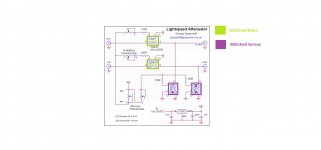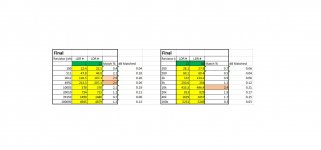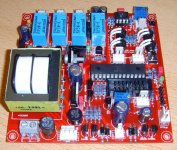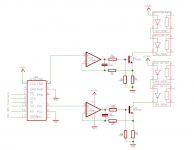Can you please send me a link where I can purchase Kemo M078.
Thank you.
Ebay.
Cheers George
If you use a kemo tester with min current of 1mA thats the same as using your 5v supply through a 5k resistor which seems to be giving you a 240ohm reading on your ldr. Hardly close the the resistance you are having problems with. If you are in fact using a switched circuit like shown in your schematics this is a great tool.
Its important to test in an area with perfect temperature. No variation. No wind/breeze. Make sure each ldr is tested the same amount of time and let them run for a good 10-15minutes before you start testing. It can get frustrating. I dont envy you. Once you get reliable matches it will be awesome.
I'll try to re-match them again. Just to be clear 100%: 2 match will should go to shunt, and two other matched to serous?
Attachments
Thanks.
The only thing that I did'n t do it - I did not wait enough time and took all measurements almost instantly.
Now, I'll wait 15 min, and the I'll measure them again.
I'll set setup my jig same as before: 100R, 500R, 2K, 5K, 10K, 20K, 40K, 100K and +5V suply.
Lets see...
The only thing that I did'n t do it - I did not wait enough time and took all measurements almost instantly.
Now, I'll wait 15 min, and the I'll measure them again.
I'll set setup my jig same as before: 100R, 500R, 2K, 5K, 10K, 20K, 40K, 100K and +5V suply.
Lets see...
Last edited:
0 results.
Ebay may only have the newer model now the yellow M078N, and it can do .5mA which is even better for you.
Cheers George
you probably meant:
Kemo M087N Light Emiting Diode Tester LED Tester Made in Germany | eBay
So, it is M087N (Not MO78N).
Kemo M087N Light Emiting Diode Tester LED Tester Made in Germany | eBay
So, it is M087N (Not MO78N).
you probably meant:
Kemo M087N Light Emiting Diode Tester LED Tester Made in Germany | eBay
So, it is M087N (Not MO78N).
Yep that's the newer one.
Cheers George
12% would give a variation of 1dB.
That 12% could come from one being higher than the other by 12%, or one being 6% lower and the other being 6% higher.
If you wanted a different dB matching then use
dB = 20 log(resistance1/resistance2)
or
ratio of resistances = inv log (dB value/20)
eg. for a 0.1dB error use inv log (0.1/20) = inv log(0.005) = 1.0156 i.e. 1.6%
That 12% could come from one being higher than the other by 12%, or one being 6% lower and the other being 6% higher.
If you wanted a different dB matching then use
dB = 20 log(resistance1/resistance2)
or
ratio of resistances = inv log (dB value/20)
eg. for a 0.1dB error use inv log (0.1/20) = inv log(0.005) = 1.0156 i.e. 1.6%
I hope you are having better luck than me Alex -
I ordered the led meter and a couple of other gadjets and asked them for a total - received this (plus the free freight notice) but that's as far as I can get - their invoice doesn't connect to Paypal link and then they send me an email page all written in German .....
This reminds me of trying to buy from Conrads (Germany) - what a frustrating experience.
Elfa (Electronics) in Sweden is so much easier to get parts from ....
I ordered the led meter and a couple of other gadjets and asked them for a total - received this (plus the free freight notice) but that's as far as I can get - their invoice doesn't connect to Paypal link and then they send me an email page all written in German .....
This reminds me of trying to buy from Conrads (Germany) - what a frustrating experience.
Elfa (Electronics) in Sweden is so much easier to get parts from ....
Finally, I'm done with the measurements and pair selection. It took me about 10 hours to finalized all 25 Optos.
So, in my previous selection (quick measurements) I got 1 set that matched after verification. 2nd set was way off particularly at the low mA. This way I got troubles I guess. So, now I used 15 min pre-heat and 2 min stabilization for each R value: 100R. 500R, 2K, 5K, 10K, 40K, 100K.
I have 2 new sets. Please see attached table. Also very nice P2P on potentiomer test when I placed Optos into PCB.
Thank you Andrew for dB cal. I calculated for direct R. I'll do soon for SpeedLight circuit when all components are in place.
So, in my previous selection (quick measurements) I got 1 set that matched after verification. 2nd set was way off particularly at the low mA. This way I got troubles I guess. So, now I used 15 min pre-heat and 2 min stabilization for each R value: 100R. 500R, 2K, 5K, 10K, 40K, 100K.
I have 2 new sets. Please see attached table. Also very nice P2P on potentiomer test when I placed Optos into PCB.
Thank you Andrew for dB cal. I calculated for direct R. I'll do soon for SpeedLight circuit when all components are in place.
Attachments
I hope you are having better luck than me Alex -
I ordered the led meter and a couple of other gadjets and asked them for a total - received this (plus the free freight notice) but that's as far as I can get - their invoice doesn't connect to Paypal link and then they send me an email page all written in German .....
This reminds me of trying to buy from Conrads (Germany) - what a frustrating experience.
Elfa (Electronics) in Sweden is so much easier to get parts from ....
Hi James,
I'm not sure if I need it. I need 2 or maybe 3 attenuators to build, so no much use for that tester. I built small jig with 7 Vishay RN60 resistors to simulate seven mAs. Second, I see those devices on eBay. So, I would buy it, then I'll go to eBay. Less headache and they accept PayPal. Thank you for advise.
Alexkosha, If you want to get a far better logarithmic feel to volume control progression, seeing your doing your own matching.
Try to get a quad matched set measured up as I do with the production Lightspeed Attenuator, this will give an excellent progressive feel to the volume controls advancement, instead of being too touchy, or way too slow.
And try to purchase the NSL32SR2S (sorted) as they have closer matched "on" resistances typically 40ohms for 20mA. Where the non sorted NSL32SR2 can have a much higher ohm variation in it's "on" resistance.
And at 1mA you get a (guaranteed +/- 1 range) of 100ohms to 110ohms with the NSL32SR2S.
(see attachments "typical" and "max" on resistance for both)
Cheers George
Try to get a quad matched set measured up as I do with the production Lightspeed Attenuator, this will give an excellent progressive feel to the volume controls advancement, instead of being too touchy, or way too slow.
And try to purchase the NSL32SR2S (sorted) as they have closer matched "on" resistances typically 40ohms for 20mA. Where the non sorted NSL32SR2 can have a much higher ohm variation in it's "on" resistance.
And at 1mA you get a (guaranteed +/- 1 range) of 100ohms to 110ohms with the NSL32SR2S.
(see attachments "typical" and "max" on resistance for both)
Cheers George
Attachments
Last edited:
Hi George,
Thank you for help.
I tried to find NSL32SR2S prior I purchased 25 pieces of NSL32SR2, but no luck.
They kinda no available, at least by now. I'll be happy if they will be back to stock at Silonex - NSL-32SR2S - Optoelectronics & Lighting - Optocouplers/Optoisolators - Allied Electronics
Thank you for help.
I tried to find NSL32SR2S prior I purchased 25 pieces of NSL32SR2, but no luck.
They kinda no available, at least by now. I'll be happy if they will be back to stock at Silonex - NSL-32SR2S - Optoelectronics & Lighting - Optocouplers/Optoisolators - Allied Electronics
Hi George,
Thank you for help.
I tried to find NSL32SR2S prior I purchased 25 pieces of NSL32SR2, but no luck.
They kinda no available, at least by now. I'll be happy if they will be back to stock at Silonex - NSL-32SR2S - Optoelectronics & Lighting - Optocouplers/Optoisolators - Allied Electronics
Search results for "NSL32SR2S" - Allied Electronics
http://az.rsdelivers.com/product/si...5-ma-max-2000-v-max-50-mw-max/2508662482.aspx
Cheers George
Last edited:
For Allied Electronics the stock is 0. They also have no ETA for refill.
For RS Components - distributor of Electronic, Electrical and Industrial Components, they do not ship to USA.

For RS Components - distributor of Electronic, Electrical and Industrial Components, they do not ship to USA.
When I first started I used to have to pre-order with Allied as well for 100 pieces, then they got them in, and they came with the same "batch number on them 2A,B.C,D,E,F or G" (see data sheet) for even better matching.
I think maybe you have to still pre order with all suppliers as they are more expensive for them to hold in stock, compared to the non "S" sorted.
Cheers George
I think maybe you have to still pre order with all suppliers as they are more expensive for them to hold in stock, compared to the non "S" sorted.
Cheers George
I have been using the "LDR-based-attenuation" for quite a while and am very content with it.
I am currently using a dual 100K log. motorized-potentiometer, which is driven by a MOTOR-H-Bridge and is controlled by IR by means of the PIC-processor of my PRE (see image 1).
But I found out that dual log. motorized-potentiometers differ a lot concerning their values.
For example: I have measured a 100K - potentiometer of producer x giving a value of at most 87K and have measured a more expensive potentiometer of producer y
giving a maximum value of 98K for section 1 and a value of 93K for section 2.
This is the reason that I have decided to change to a digital potentiometer for my future design.
Here it is (image 2):
I will use a 100K dual digital potentiometer (MCP42100) being followed by a VCCS, consisting of a LM358 and a BC546 and some discrete components.
The VCCS' sense resistor limits the current that is flowing through the LDRs to about 20mA.
My LTSPICE-simulation is showing the results that I am expecting.
I match the LDRs manually.
Will I do a big error following this idea?
Best regards - Rudi_Ratlos
I am currently using a dual 100K log. motorized-potentiometer, which is driven by a MOTOR-H-Bridge and is controlled by IR by means of the PIC-processor of my PRE (see image 1).
But I found out that dual log. motorized-potentiometers differ a lot concerning their values.
For example: I have measured a 100K - potentiometer of producer x giving a value of at most 87K and have measured a more expensive potentiometer of producer y
giving a maximum value of 98K for section 1 and a value of 93K for section 2.
This is the reason that I have decided to change to a digital potentiometer for my future design.
Here it is (image 2):
I will use a 100K dual digital potentiometer (MCP42100) being followed by a VCCS, consisting of a LM358 and a BC546 and some discrete components.
The VCCS' sense resistor limits the current that is flowing through the LDRs to about 20mA.
My LTSPICE-simulation is showing the results that I am expecting.
I match the LDRs manually.
Will I do a big error following this idea?
Best regards - Rudi_Ratlos
Attachments
Last edited:
- Home
- Source & Line
- Analog Line Level
- Lightspeed Attenuator a new passive preamp



